Black Footed Ferrets were once considered extinct until the discovery of a small population in 1981. Then through breeding and reintroduction programs, the Black-Footed Ferrets population has significantly recovered. We have gathered a complete set of Black Footed Ferret Facts that will help you in learning all about Black Footed Ferret. You are going to learn its scientific name, taxonomy, family, species, appearance, size, lifespan, diet, prey, hunting, food web, habitat, range, behavior, babies, adaptations, predators, population, IUCN status, endangerment, protection, importance, reintroduction and many other interesting facts about the Black-Footed Ferret.
Black Footed Ferret Facts
1. What Is A Black Footed Ferret
- The black-footed ferret is a mustelid species indigenous to central North America.
- It is also known as a prairie dog hunter or American polecat.
- It is a small mammal, about 1.5 to 1.7 feet in size.
- It is a carnivore and eats prairie dogs as its major diet.
- The black-footed ferret was once declared as an extinct species, however, the United States Fish and Wildlife Service launched a captive-breeding program and reintroduced it into 8 western states of the USA, Mexico, and Canada.
- In 2011, their population in the wild was over 1,000 mature individuals.
- Major threats to its survival are habitat loss and diseases.
- Their conservation status is now as an “Endangered” species on the IUCN Red List of Threatened Species.
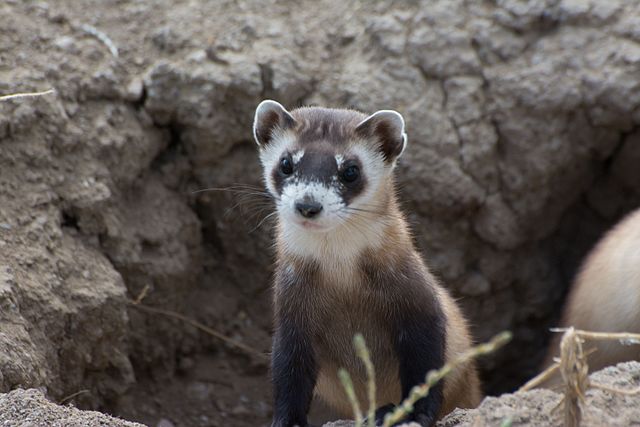
2. Black Footed Ferret Scientific Name
- The scientific name of the black-footed ferret is Mustela nigripes.
3. Black Footed Ferret Family
- The black-footed ferret belongs to the family Mustelidae.
- Carnivore mammals like ferrets, weasels, otters, badgers, minks, martens are included in this family.
- It is the largest family of the order Carnivora and suborder Caniformia and is comprised of around 56 to 60 species.
- All the individuals of the family Mustelidae have some common characteristics such as; small elongated bodies, small and round ears, thick fur, and short legs.
4. Black Footed Ferret Species
- The black-footed ferret is one of the 17 species of the genus Mustela.
- This species is native to Central North America.
5. What Does A Black Footed Ferret Look Like – Black Footed Ferret Description
- The black-footed has a long and slim body.
- It has a long neck and short legs.
- They have a body size of about 15 to 20 inches.
- They have 4.2 to 5.0 inches long tails.
- Their body weight ranges from 1.43 to 3.09 pounds (650 to 1,400 grams).
- The whole body is covered with fur of a pale yellow or buff color.
- Ears, some parts of the face, feet, and tail have outlines of black color.
- The side regions of the ears and face have a dirty white color.
- They have a broad forehead and a short muzzle with few whiskers.
- The feet are entirely covered with fur and the claws are hidden in the fur at soles.
- They have slightly arched and extremely sharp claws.
6. How Big Is A Black Footed Ferret – Black Footed Ferret Size
- The size of a mature male black-footed ferret ranges between 19.7 to 12.0 inches (500 to 533 mm).
- The tail length is from 4.5 to 5.0 inches (114 to 127 mm).
- The size of male individuals is usually 10% greater than females.
- The captive-bred black-footed used in the reintroduction program was observed as relatively smaller than their wild counterparts. However, they attained historical body sizes upon release to the wild.
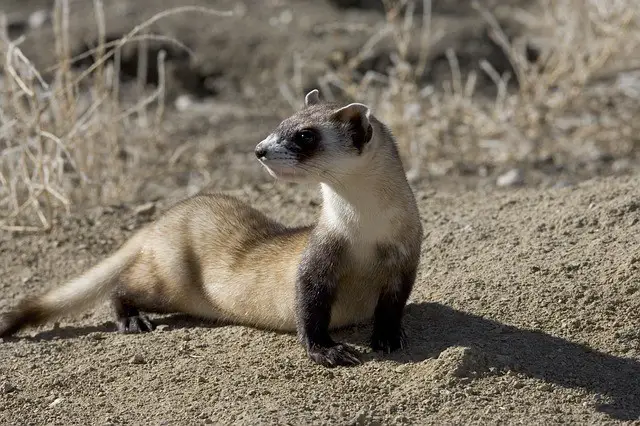
7. How Long Do Black Footed Ferrets Live – Black Footed Ferrets Lifespan
- The average lifespan of black-footed ferrets in the wild is 1 to 3 years.
- Few individuals live beyond 4 to 5 years in the wild.
- According to National Geographic, the average lifespan of a black-footed ferret in captivity is 12 years.
8. What Do Black Footed Ferrets Eat – Black Footed Ferret Diet
- Up to 90% diet of the black-footed ferret is comprised of prairie dogs.
- Their diet changes according to geographic location.
- Their major diet is white-tailed prairie dogs in western Colorado, Wyoming, Utah, and Montana.
- They had to find alternative prey during the four-month hibernation cycle of the white-tailed prairie dogs. The main alternative preys were voles and mice.
- In South Dakota, the major diet of the black-footed ferret is black-tailed prairie dogs.
- According to a 1983 study, an adult female black-footed ferret and her litter annually need about 412 to 1,236 white-tailed prairie dogs or 474 to 1,421 black-tailed prairie dogs for their survival.
- When 82 scats of the black-footed ferrets were observed in Mellette County, South Dakota, the remains of black-tailed prairie dogs were found in 91% of scats while the remains of the mouse were found in 26% of scats.
- In another study, 86 scats of the black-footed ferrets were observed near Meeteetse, Wyoming. It was found that they consumed white-tailed prairie dogs as 87% of their diet, while other food items were mice, voles, mountain cottontails, and white-tailed jackrabbits.
- In captivity, they are fed with commercial carnivore meat mix, rates, and mice.
Is A Black Footed Ferret A Carnivore
- Yes, a black-footed ferret is a carnivore.
- It fulfills more than 90% of its dietary requirements by eating the flesh or meat of other animals.
9. Black Footed Ferret Prey
- The major prey items of the black-footed ferret are;
- White-tailed prairie dogs
- Black-tailed prairie dogs
- Other potential prey items are;
- several mice species (house mice, deer mice, northern grasshopper mice)
- White-tailed jackrabbits
- thirteen-lined ground squirrels
- Meadow voles
- Sagebrush voles
- Mountain cottontails
- Plains pocket gophers
- Horned larks
- Upland sandpipers
- Western meadowlarks
10. How Do Black Footed Ferrets Hunt – Black Footed Ferret Hunting
- The slender body of the black-footed ferrets allows them to crawl in and out of the dwellings and holes of the prairie dogs, which are their primary prey.
- They hunt prairie dogs in their dwellings and borrows.
- They use their sharp claws to grasp the prey and then kill it with a quick bite on the neck or throat.
- They also take shelter in the abandoned dwellings of the prairie dogs.
11. Black Footed Ferret Eating Prairie Dog
- Black-footed ferrets have a high metabolic rate and these small animals need a large quantity of food.
- Generally, a black-footed ferret consumes one prairie dog in three to four days.
- The annual consumption of a black-footed ferret is about 100 prairie dogs.
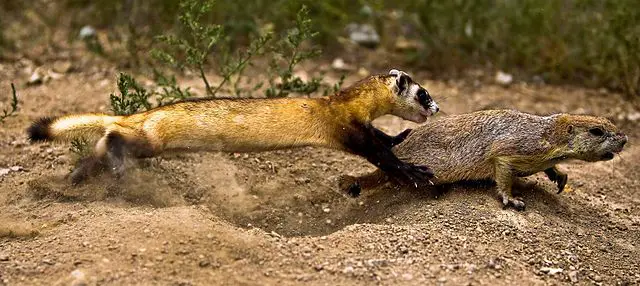
12. Black Footed Ferret Food Web
- The following is the food web of the black-footed ferret:
- The sun is the source of all energy in the above food web.
- Plants use the sun’s energy directly to prepare their food.
- Many types of insects, small rodents, ground squirrels, and small birds consume plant matter and grains.
- The prairie dogs eat plant matter and insects.
- The black-footed ferrets mainly consume prairie dogs as well as small rodents, ground squirrels, and small birds.
- The American badger, bobcat, prairie falcon, golden eagle, coyote, and prairie rattlesnake hunts black-footed ferrets.
- The apex predators in the food web are lion, wolf, and great horned owl. No animal can hunt them.
- Humans are the only predators of the apex predators and would hunt them not only for their meat.
13. Where Do Black Footed Ferrets Live – Black Footed Ferret Habitat
- The black-footed ferret’s historic habitats included mixed-grass prairie, short-grass prairie, desert grasslands, sagebrush steppe, shrub-steppe, semi-arid grassland, and mountain grassland.
- They use the burrows of prairie dogs to raise their young ones, which provides them a thermal covering and protection from predators.
- Black-footed ferrets get the greatest amount of shelter if the densities of the prairie dog burrows are high.
- The per acre burrow density of the colonies of the black-tailed prairie dog is high as compared to the white-tailed prairie dogs and maybe more suitable for the black-footed ferret recovery.
- White-tailed prairie dogs make mounted burrows with deep and extensive burrow systems and with multiple entrances. It would provide more protection to the kits of black-footed ferrets.
- However, the black-footed ferrets are observed using a less amount of the mounded borrows (about 30%) as compared to the non-mounded borrows (about 64%).
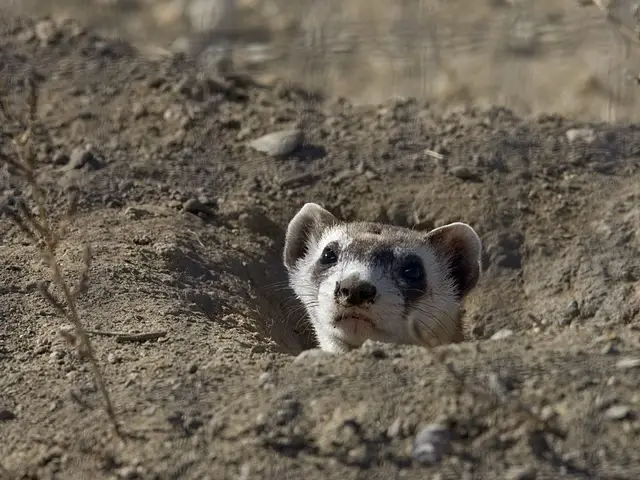
14. Where Are Black Footed Ferrets Located – Black Footed Ferret Range
- The black-footed ferrets are indigenous to central North America.
- Their historical range was extended throughout the North American Great Plains and had a close association with the range of the prairie dogs, however, not only restricted to the prairie dog’s range.
- Its range extended from the southern regions of the Canadian provinces Alberta and Saskatchewan to the U.S states of Arizona, New Mexico, and Texas.
- In 2007, their only known population in the wild was located on about 2,400 hectares (6,000 acres) in the western region of the Bighorn basin near Meeteetse town, Wyoming.
- Currently, the black-footed ferrets are reintroduced into parts of their former habitat range in South Dakota, Wyoming, Arizona, Colorado, Montana, and Utah in the USA, in Grasslands National Park in Canada, and northern Chihuahua in Mexico.
15. Black Footed Ferret Range Map – Black Footed Ferret Habitat Map
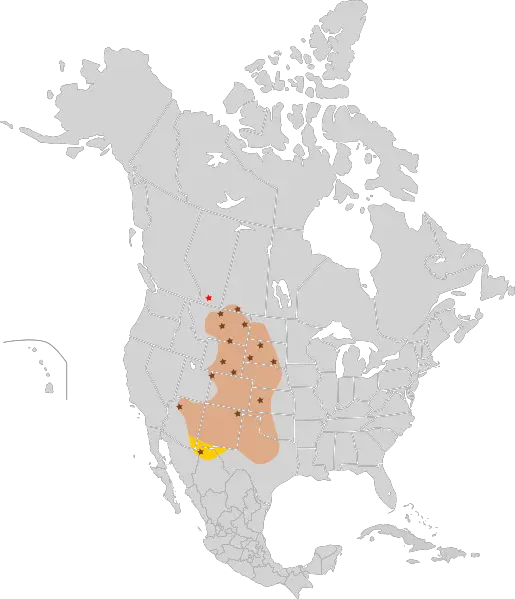
16. Are Black Footed Ferrets Nocturnal
- Yes, black-footed ferrets are nocturnal.
- They spend about 90% of their time underground in prairie dogs’ burrows where they raise their young ones, eat, and sleep.
- At night they leave their burrows to prey.
17. Black Footed Ferret Behavior
- The black-footed ferret is a solitary animal and mostly lives alone, except during the breeding season.
- It is nocturnal and spends about 90% of its time underground.
- It hunts sleeping prairie dogs at night in their burrows.
- Its most active time at the ground is from dusk to midnight and from 4 a.m to mid-morning.
- Black-footed ferrets are also more active during late summer and early autumn. It is the time when juveniles become independent.
- Climate change does not affect their activity, however, they may be inactive inside their burrows for up to 6 days during winter.
- Females have a relatively smaller home range than their male counterparts. The home range of a male black-footed ferret may be equal to the home range of several females.
- Females usually do not change their territory and occupy the same region every year.
- The black-footed ferret makes several noises such as; hisses, whimpers, and chatters.
- They are also known for their playful nature. The younger ones often wrestle with each other.
18. Baby Black Footed Ferret
- A baby black-footed ferret is known as a kit.
- A mother would have 1 to 5 kits at a time.
- Kits are born in the burrows of prairie dogs after a gestation period of 42 to 45 days, usually from May to June.
- They are born underdeveloped and stay with the mother for several months after birth.
- When they become 6 weeks old, they emerge above the ground for the first time (usually in July).
- The mother then separates them into individual prairie dog that burrows around her burrow.
- After several months of their birth, the kits attain adult weight and become independent from late August to October.
- Upon independence, the juvenile black-footed ferrets disperse. The distances of dispersal may be short or long.
- The juveniles become sexually mature at the age of one year.
How Many Babies Do Black Footed Ferrets Have
- Black-footed ferrets have 1 to 5 babies.
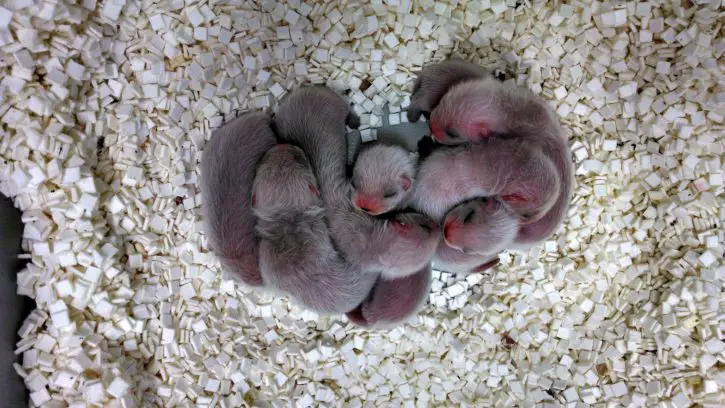
19. Black Footed Ferret Adaptations
- The following are the main adaptations of the black-footed ferret:
Fur Color
- Despite black marking on the legs and head, black-footed ferrets have a sandy color of fur, which resembles the color of the ground. It provides them camouflage against predators.
Slender Body
- Black-footed ferrets have a slender body shape that allows them to easily approach prairie dogs in their burrows.
Powerful Jaws
- Black-footed ferrets have powerful carnivore jaws. It allows them to kill prey with only a quick fatal bite.
Nocturnal Activity
- Black-footed ferrets are nocturnal and are most active from dusk to midnight.
- They can skillfully hunt in the dark.
- The nocturnal activity also allows them to avoid predators and kill the sleeping prairie dogs easily in their burrows.
Sharp Senses
- Black-footed ferrets have sharp senses of vision, hearing, and smell.
- They can see in low light and maybe in the dark.
- They can detect any danger approaching them from a long distance through hearing.
- Their excellent sense of smell makes them able to sniff out hiding prey in their burrows.
20. What Are Black Footed Ferrets Predators – Black Footed Ferret Predators
- The following are the major predators of the black-footed ferret:
- Golden eagle
- Ferruginous hawk
- Great horned owl
- Prairie falcon
- Bobcat
- American bodgers
- Coyote
- Prairie rattlesnake
21. How Many Black Footed Ferrets Are Left – Black Footed Ferret Population
- In 2011, there were around 1,000 black-footed ferrets across the central U.S.
- According to Defenders of Wildlife, only 350 black-footed ferrets are left.
- The current population of black-footed ferrets in the wild is about 300 to 400.
How Many Black Footed Ferrets Are Left 2018
- In 2018, the population of the black-footed ferrets was roughly estimated as 300-400 mature individuals in the wild.
How Many Black Footed Ferrets Are Left 2019
- According to the Smithsonian National Zoo, there are roughly 300 to 400 black-footed ferrets in the wild.
22. Are Black Footed Ferrets Endangered
- Yes, the black-footed ferret is listed as an Endangered species by the IUCN Red List of Threatened Species.
23. When Did The Black Footed Ferret Become Endangered
- In 1979, black-footed ferrets were declared extinct.
- In 1982, it was listed as endangered.
- Later in 1992, it was listed as “extinct in the wild”.
- In 2008, its status was changed back to “endangered”, which is still its conservation status.
24. Why Are Black Footed Ferrets Endangered – Black Footed Ferret Threats
- There are many reasons for the black-footed ferrets’ endangeredness. The major ones are:
Diseases
- Black-footed ferrets are fatally susceptible to many diseases, especially to canine distemper virus.
- Other animal species such as red foxes, coyotes, American badgers, common raccoons, and striped skunks introduce this disease.
- For captive black-footed ferrets, a short-term vaccine is available. However, the kits born in the wild are not protected and are widely susceptible to this fatal virus.
- Other diseases that affect black-footed ferrets are; human influenza, rabies, and tularemia.
- Sylvatic plague and other epidemics in the town of the prairie dogs can destroy the prey bases of the black-footed ferrets.
Habitat Loss
- Livestock, agriculture, and other human developments cause the prairie dogs’ habitat loss.
- Balck-footed ferrets are obligate dependents on prairie dogs and are extremely vulnerable to the prairie dogs’ habitat loss.
Indirect Poisoning
- Farmers and herders use special techniques including poisons to control prairie dog populations.
- The black-footed ferrets become indirectly poisoned and die in case of eating poisoned prairie dogs.
Exploration and Extraction of Oil and Natural Gas
- Natural gas and oil exploration and extraction also influence black-footed ferrets.
- Burrows of the prairie dogs inhabited by black-footed ferrets collapses due to seismic activities.
- Other problems and threats to the survival of black-footed ferrets are: spills and potential leaks of oil or gas, increased fences and roads, vehicle traffic, increased human presence, a large number of raptor perching sites on the power poles, and traps set for American mink, coyote, and other animals.
25. Why Are Black Footed Ferrets Going Extinct
- The black-footed ferrets were going to become extinct because of:
- Diseases
- Habitat loss
- Loss of prey
- However, they are reintroduced into the wild through several projects.
- Their current conservation status is “Endangered”.
26. What Is Being Done To Save The Black Footed Ferret
- A lot of efforts have been done to save the black-footed ferrets.
- In 1987, a captive breeding program was started in which 18 living individuals were captured. They were reproduced through an effective scientific reproductive technique known as artificial insemination. The black-footed ferret is the first example of an endangered species this technique was used for its conservation.
- Since 1991, the U.S. Fish and Wildlife Service, state and tribal agencies, conservation groups and organizations, North American zoos, and private landowners actively worked to reintroduce black-footed ferrets into the wild.
27. How Can We Help Black Footed Ferrets
- We can help the black-footed ferrets in the following ways:
- We can symbolically adopt a black-footed ferret. It would help to save the real black-footed ferrets in the wild.
- We can assist organizations that are working on the maintenance of the existing sites of the black-footed ferrets.
- We can assist the reintroduction programs in which, prairie dogs are relocated to establish new reintroduction sites and to increase the black-footed ferrets’ habitat.
- We can participate in the oral vaccine research, physically if we could or via funding, to protect the black-footed ferret’s food source (prairie dogs) from the Sylvatic plague.
28. Why Are Black Footed Ferrets Important – Is The Black Footed Ferret A Keystone Species
- A keystone species is a species that has a disproportionately large influence on its natural ecosystem relative to its abundance.
- The black-footed ferret is considered a keystone species along with prairie dogs.
- They are important for a healthy ecosystem.
- It is both a predator and prey.
- It keeps the population of prairie dogs in control.
- It is also a food source for other animals, such as American badgers, coyotes, bobcats, golden eagles, etc.
29. What Would Happen If Black Footed Ferrets Went Extinct
- If black-footed ferrets went extinct, the ecosystem of the region where they were found would be disturbed.
- There would be a lot of prairie dogs that would affect agriculture and must be controlled in other ways.
- There would be also decreased food for the predators of the black-footed ferrets.
- The presence of black-footed ferrets is an indicator of a healthy environment and there would be many problems if it became extinct.
30. Black Footed Ferret Reintroduction
- The United States Fish and Wildlife Service, conservation organizations, state and tribal agencies, North American zoos, and private landowners made a lot of efforts since 1991 for the reintroduction of the black-footed ferrets into the wild.
- The reintroduction program was started in the Shirley Basin of Eastern Wyoming and was further extended to Montana, 6 sites in Southern Dakota, Utah, Arizona, Colorado, Saskatchewan province of Canada, and the Mexican state of Chihuahua.
- Hundreds of the black-footed ferrets were bred in the Toronto Zoo most of which were released into the wild.
- In October 2009, a population of 35 black-footed ferrets was released into the Grassland National Park located in the Southern region of Saskatchewan.
31. Can You Have A Black Footed Ferret As A Pet
- The black-footed ferret is an endangered species and having an endangered animal as a pet without a permit is illegal.
- In the U.S. states of Columbia, California, and Hawaii, it is against the law to possess a black-footed ferret as a pet.
- While other states have a system of strict regulations about having, selling, importing, feeding, and vaccinating the black-footed ferrets.




